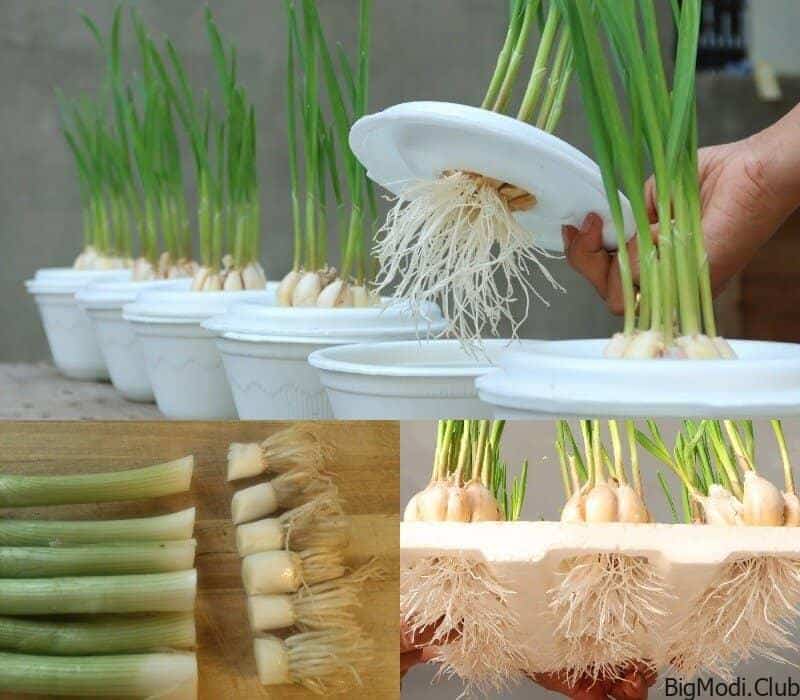Growing garlic and onions can transform your garden into a vibrant and productive space. Both of these versatile plants offer numerous benefits, from enhancing the flavor of your dishes to providing natural pest control. Whether you’re an experienced gardener or a beginner, understanding the best practices for growing garlic and onions will help you maximize their potential.
In this comprehensive guide, we’ll explore everything you need to know about planting garlic and onions. You’ll learn about the different types of garlic, ideal growing conditions, and how to successfully cultivate these plants in both traditional garden beds and containers. We’ll also discuss the best companion plants for garlic and onions, ensuring that your garden thrives with optimal health and productivity.
By following these tips, you’ll be well on your way to growing garlic and onions that not only enrich your meals but also contribute to a healthier, more balanced garden ecosystem.
How to Plant Garlic and Onions: A Comprehensive Guide
Garlic Planting Guide
Types of Garlic:
When choosing garlic to plant, you’ll encounter two main types:
- Softneck Garlic: Often found in supermarkets, this variety stores well and is suitable for milder climates.
- Hardneck Garlic: Known for its hardier nature, this type thrives in colder regions and produces robust flavors.
Growing Conditions:
Garlic thrives in a sunny, warm location with fertile, well-draining soil. Ideal planting times are late autumn or early winter, though early spring planting is an option for heavy soils. Garlic can be grown directly in the ground or in containers.
Planting Instructions:
- Preparation: Separate garlic bulbs into individual cloves. For planting, place the larger cloves with the fat end facing downwards and the pointy end approximately 2.5 cm below the soil surface.
- Spacing: Plant cloves 15 cm apart in rows that are 30 cm apart.
- Protection: Cover young plants with netting or fleece to deter birds until the shoots reach 5 cm in height. In colder regions, use cloches to shield plants over winter.
Soil Preparation:
Before planting, clear the soil of weeds and remnants of previous crops. Enrich the soil by incorporating homemade compost or well-rotted manure.
Alternative Planting Methods:
For heavy clay soils, start by planting garlic cloves in module trays during autumn. Grow them in a cold frame before transplanting in spring. Alternatively, plant garlic in raised mounds to avoid rot in wet conditions.
Supermarket Garlic:
Although you can use supermarket garlic for planting, it’s not advisable due to the risk of viral infections. Opt for certified virus-free planting stock for healthier crops.
Onion Planting Guide
Location and Soil Preparation:
Select a sunny spot with no shade from surrounding plants. Enhance soil texture by mixing in aged manure or compost either in the fall or early spring. Ensure the soil is loose, well-draining, and free of debris.
Planting Instructions:
- Preparation: Onions are nutrient-hungry plants. Add a nitrogen-rich fertilizer at planting time.
- Trenching: Dig a trench about 2 inches deep and 3 inches wide, then fill it with an inch of compost.
- Planting: Bury onion sets 2 to 6 inches apart, pressing them 1 to 2 inches deep into the soil. Space transplants 4 to 5 inches apart, with rows 12 to 18 inches apart. Plant bulbs with the pointy end up and avoid burying them deeper than 2 inches.
- Mulching: Use straw mulch between rows to retain moisture and control weeds.
Planting Onions and Garlic Together
Compatibility:
Though onions and garlic belong to the same plant family and can be grown together, it’s generally best to plant them separately to avoid competition for nutrients.
Soil and Location:
Both crops prefer light, well-drained soils and thrive in sunny locations with fertile ground. Avoid overly wet or acidic conditions.
Planting Technique:
If planting onions and garlic together, ensure a spacing of about 20 cm (8 inches) between rows to prevent overcrowding. Plant seeds or bulbs at a shallow depth to promote even sprouting.
Crop Rotation:
To maintain soil health and reduce disease risk, rotate the planting locations of onions and garlic every few years.
Care Tips:
Loosen the soil around the plants regularly and manage weeds to keep the soil nutrient-rich. Water sparingly, especially in early spring when snowmelt provides natural moisture.
Protection and Disease Management:
Prevent common diseases by treating planting materials with solutions of potassium permanganate or copper sulfate before planting. Consider adding pest-repelling flowers, like marigolds, near onions and garlic to deter harmful insects.
Garlic and Onions: Perfect Companions for Your Garden
The Benefits of Companion Planting with Garlic
Companion planting is a strategic gardening technique that enhances plant health and productivity. Garlic stands out as a superb companion plant due to its natural pest-repelling properties. The sulphur compounds in garlic bulbs act as both a fungicide and an insect deterrent, making garlic an excellent addition to various garden settings.
Ideal Plant Pairings for Garlic
Garlic thrives alongside many plants, offering mutual benefits. Here’s a guide to what pairs well with garlic:
- Tomatoes: Garlic helps protect tomatoes from pests and diseases.
- Fruit Trees: The protective properties of garlic can extend to fruit trees, keeping harmful insects at bay.
- Potatoes: Garlic’s pest-repelling qualities benefit potato plants.
- Cabbages: Garlic wards off pests like cabbage worms and maggots that often trouble cabbage crops.
- Broccoli, Cauliflower, Kale: Other Brassicas such as broccoli and cauliflower also benefit from garlic’s protective effects.
- Carrots: Planting garlic near carrots can help repel the carrot fly, safeguarding your carrot harvest.
Plants to Avoid Near Garlic
While garlic is versatile, it doesn’t pair well with everything. Specifically, avoid planting garlic near peas and beans, as it may inhibit their growth.
Garlic’s Protective Impact
Garlic’s benefits extend beyond its immediate vicinity. For instance, planting garlic around rose bushes can deter aphids, snails, caterpillars, and other pests. For optimal results, place three to four garlic cloves in a circle around each rose bush to shield your flowers.
Onions and Their Ideal Companions
Onions are not only flavorful but also enhance the growth and health of neighboring plants. They are particularly effective at repelling a variety of garden pests, making them a valuable addition to your garden.
Effective Companions for Onions
Onions work well with several plants, thanks to their ability to deter pests and enhance growth. Here’s a list of ideal companions:
- Cabbage: Onions keep pests like cabbage worms and loopers away from Brassica crops such as cabbage, broccoli, kale, and cauliflower.
- Chamomile: This herb not only complements the flavor of onions but also provides antibacterial and antifungal benefits.
- Summer Savory: Known to promote onion growth and impart a subtle sweetness.
- Carrots: Planting onions with carrots helps repel carrot flies, safeguarding the carrot crop.
- Leeks: Sharing similar needs, onions and leeks can coexist harmoniously, with leeks helping to confuse onion flies.
- Beets: Onions, along with garlic and leeks, offer protection against aphids, sugar beet-flea beetles, and other pests.
- Lettuce: The differing root depths of onions and lettuce allow for efficient space use without competition.
- Strawberries: Onions help protect strawberries from aphids and other pests, improving the health of the strawberry plants.
- Tomatoes: The strong smell of onions can deter pests from damaging tomato plants.
- Swiss Chard: Large Swiss chard leaves keep the soil moist, creating a suitable environment for onions.
- Marigolds: These vibrant flowers attract beneficial insects that aid in pollination and pest control.
Plants to Avoid with Onions
Avoid planting onions near peas, pole beans, bush beans, and asparagus, as these plants do not grow well in the presence of onions.
Growing Onions and Garlic in Containers
Container gardening offers flexibility and convenience, especially for those with limited space. Both onions and garlic can thrive in containers, making them ideal for urban gardens or small spaces.
Choosing the Right Containers
Select containers with adequate depth and width to accommodate the relatively small root systems of onions and garlic. Containers around 8 inches in diameter are suitable for planting onions and garlic. For garlic, consider using containers that can hold 4 to 5 heads to ensure proper bulb development.
Soil and Planting Tips
Use a high-quality potting mix, such as organic potting mix, for planting. Follow standard planting instructions:
- Onions: Plant white onion sets aiming for a harvest size that suits your preference. Distribute sets around the garden and in containers to avoid waste.
- Garlic: Opt for hardneck varieties for their robust flavor and good bulb formation. You might need one or two containers to give garlic enough room to bulb up.
Experimentation and Placement
Try different container placements for onions and garlic, such as around the edges of grow bags or in various garden spots. Observing whether these plants can deter pests like squirrels can provide useful insights for future gardening strategies.
Harvesting
If you have excess onions or garlic, you can harvest them as green onions or immature bulbs if needed. This approach prevents waste and makes the most of your planting efforts.


